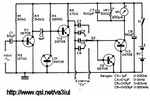neazoi
Advanced Member level 6
Hi I have found this frequency counter circuit which worked ok but I have a problem.
The range I am interested is 480Hz-2.7KHz only. Can I transform the circuit somehow to cover only this range, so that the meter spreads throughout it's whole scale instead of part of it, so as to increase the resolution of the meter?
Also I have no idea how the meter works, perhaps if I knew I could derive the modifications myself.
Any other such analogue meters with discrete components? I cannot find any on the net. Maybe you remember one from old magazines?
The range I am interested is 480Hz-2.7KHz only. Can I transform the circuit somehow to cover only this range, so that the meter spreads throughout it's whole scale instead of part of it, so as to increase the resolution of the meter?
Also I have no idea how the meter works, perhaps if I knew I could derive the modifications myself.
Any other such analogue meters with discrete components? I cannot find any on the net. Maybe you remember one from old magazines?
Attachments
Last edited:

